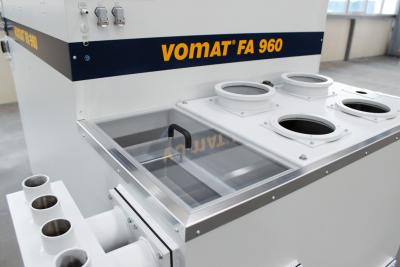
For grinding modern cutting tools, all parameters that are involved in the manufacturing process must be optimally coordinated with each other. Only in this way can drills or milling cutters be produced in large quantities with consistent high quality as expected by the market. An important part of the puzzle is microfiltration technology. The filtration technology must not only ensure very high purity of a variety of lubricants over a long period of time but also must be of a design that is flexible enough to grow easily with production capacity expansion.
The filtration specialist VOMAT from Germany provides high-performance filtration technology – from small stand alone to large industrial central systems – which are designed to meet customer specific requirements and are of modular design. As a result, they can be quickly and easily adapted to changing requirements in the company.
VOMAT systems operate in full-flow mode and separate dirty and clean oil 100 percent thanks to a high-performance precoat filter design. This results in enhanced purity of the cooling lubricants to NAS 7 or 3-5 μm particle size. In addition, the systems adapt automatically to varying production volumes and initiate the filter backwash cycle depending on the contamination level of each filter element. The back-flushing of each individual filter cartridge instead of the whole filter bank at the same time allows the system to operate with high energy efficiency while keeping in optimal synchronization with the customer's grinding machines. The Vomat FA stand-alone models offer filtration capacities of 70 to 960 liters (18 - 254 Gallons) and are extremely compact. This keeps the transport costs low, minimizes building modifications and saves precious production floor space.
Steffen Strobel, technical sales manager with VOMAT, states: "VOMAT filtration systems grow with the success or needs of our customers. Thus, standard systems can be adapted to increased or changed production requirements by means of additional modules such as digital displays for visualizing the filtration process, frequency-controlled machine supply pumps or internal and external prefilters, as well as a variety of cooling systems. In addition systems can be designed for individual plant configurations and can be integrated seamlessly into any workflow. This includes large-scale industrial plant-wide central systems with optimal cooling and disposal concepts. Even if there are changes in production requirements, with our help the customer is ensured that his filtration system is adapted to current conditions."
Contact Details
Related Glossary Terms
- gang cutting ( milling)
gang cutting ( milling)
Machining with several cutters mounted on a single arbor, generally for simultaneous cutting.
- grinding
grinding
Machining operation in which material is removed from the workpiece by a powered abrasive wheel, stone, belt, paste, sheet, compound, slurry, etc. Takes various forms: surface grinding (creates flat and/or squared surfaces); cylindrical grinding (for external cylindrical and tapered shapes, fillets, undercuts, etc.); centerless grinding; chamfering; thread and form grinding; tool and cutter grinding; offhand grinding; lapping and polishing (grinding with extremely fine grits to create ultrasmooth surfaces); honing; and disc grinding.
- milling
milling
Machining operation in which metal or other material is removed by applying power to a rotating cutter. In vertical milling, the cutting tool is mounted vertically on the spindle. In horizontal milling, the cutting tool is mounted horizontally, either directly on the spindle or on an arbor. Horizontal milling is further broken down into conventional milling, where the cutter rotates opposite the direction of feed, or “up” into the workpiece; and climb milling, where the cutter rotates in the direction of feed, or “down” into the workpiece. Milling operations include plane or surface milling, endmilling, facemilling, angle milling, form milling and profiling.
- modular design ( modular construction)
modular design ( modular construction)
Manufacturing of a product in subassemblies that permits fast and simple replacement of defective assemblies and tailoring of the product for different purposes. See interchangeable parts.

